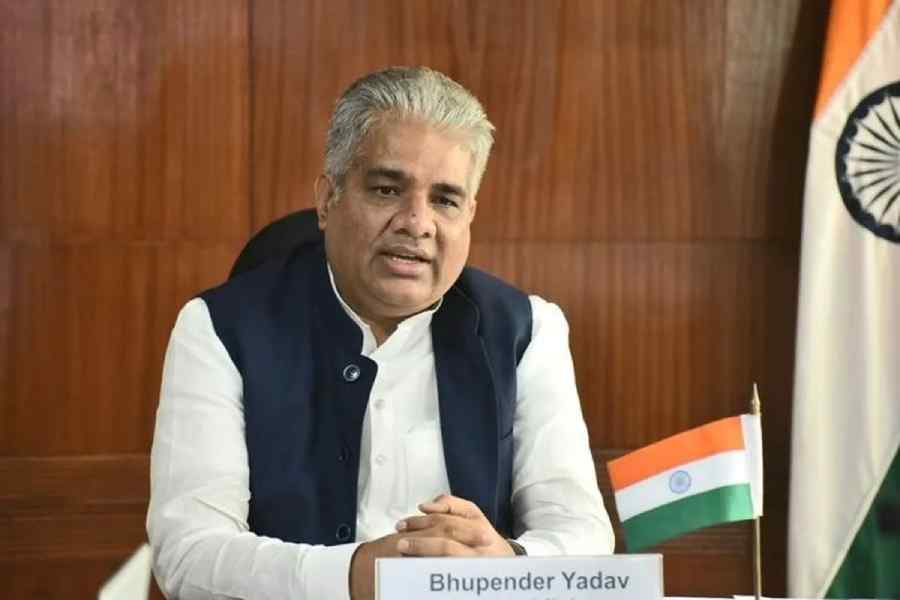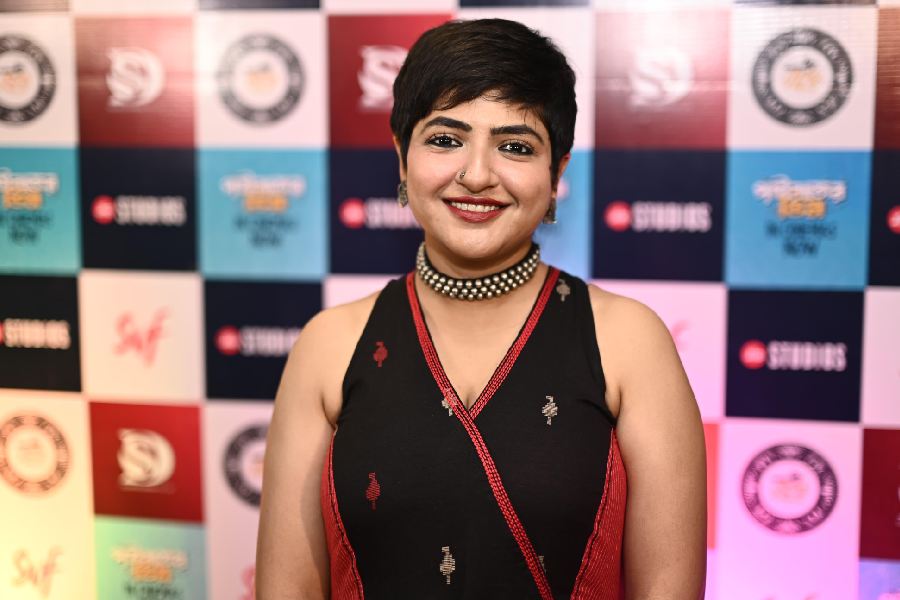 |
| Trinamul’s Shatabdi Roy campaigns near Rampurhat. Picture by Sanjoy Chattopadhyaya |
Lal Paan Bibi is a bloodthirsty “murderer”. She wants to kill her father’s killers. But she is also cute and bubbly and sings and dances and even rides a bike in brightly coloured clothes.
She has an identical sister, a policewoman, who is correct and stern.
Both are played by Shatabdi Roy in the film Lal Paan Bibi. It’s Roy’s biggest hit. If there is one role that the masses love her for, it is of Lal Paan Bibi (named after the character’s habit of playing satta from childhood, lal paan being the heart series of cards).
It would be too overwhelming for a Bengal village if Lal Paan Bibi appeared in person. It is not very easy to campaign as a policewoman either. Perhaps that’s why Shatabdi Roy as the Trinamul Congress candidate from Birbhum — the biggest role of her life? — looks a bit like a schoolteacher, if a glamorous one.
In the villages, she looks like the favourite teacher.
She is certainly dressed like a schoolmistress.
The actress is currently the most famous landmark in Rampurhat, a small town in Birbhum near Tarapith. Her schedule for the day is “light” — four meetings till 11.30, followed by a three-hour break.
“Yesterday I attended 20 meetings. I was feeling faint,” she says. “I have covered almost 1,900 of the 2,200 villages in the constituency. The people have been very enthusiastic.”
She steps out at 9am, wearing a tussar-coloured sari with a maroon border and a full-sleeved maroon blouse. Her face is done up, lightly, her eyes are lined, her lips are glossed, her cheeks are rouged. Her hair is shoulder-length with brown tints. She is bespectacled, her face is composed in a smile, not a hair out of place. In fact it is held back by a clasp. She walks briskly to the silver-grey SUV and jumps into the front seat.
She would look perfect in a remake of Jai Jayanti, the Bengali version of The Sound of Music. It is soon evident that children like her, too.
Perhaps the schoolteacher demeanour is also meant to protect her from the adulation.
Once she was at a meeting in a big hall. The doors were closed after she was in, but the huge crowd outside wouldn’t stay away. They broke open the doors and burst in. Since then Roy hasn’t addressed a meeting in a closed space.
A woman held on to Roy so tight once that her nails dug into Roy’s flesh.
In such moments Roy feels the difference between being an actor and a political leader. “I have travelled in Bengal extensively for stage performances, but as an actress I was always protected. There are people forming a ring around you.”
Is it scary meeting the crowd face to face? “The love that I am getting is overwhelming,” says Roy.
With Mamata Banerjee, however, she is the pupil, Didi the teacher. “I have come into politics only because of Mamatadi,” says Roy. “She is the supremo. There is no one in the party who will go against her.”
On Roy’s agenda are big issues, which are local as well as general, for Bengal. “Roads, electricity, hospitals, schools. We will usher in change.”
“Change”, of course, is the Trinamul synonym for Mamata Banerjee.
As Roy approaches the first meeting in the Mohammadbazar area, about 35km from Rampurhat, she switches to the teacher mode again. As soon as her vehicle reaches the meeting ground, she gets down briskly and is up on the stage with a local Trinamul leader.
“One of the complaints of the CPM has been that I am a bahiragata (outsider),” she says later.
At the meeting, Roy doesn’t waste time. She sticks to the practical. “All your love will only translate into reality if you vote for me on May 7. You will have to press the fourth button, next to the jora phool (two-flower) symbol,” she says in a slow, measured, deliberate tone.
She has a special message for women. She tells them they should exercise their minds. “You know your candidate. Do not listen to anyone else. And please do not cook that day. Vote first, then come back and dice the potatoes.”
She has a message for children, too. “Ai toder- kaaj korte hobe (you too will have to work). Please tell your baba, ma, chacha, chachi (parents, uncles and aunts — this is a village with a Muslim population) to vote for jora phool.”
At the next meeting, she shows a dummy EVM, holding it up from various points of the stage for everyone to see. “This is where you vote,” she says, pointing at the fourth button. She wants the villagers to be in no doubt about the shape, appearance and position of the right button and the party symbol, a reminder of the reach of illiteracy in Bengal’s interiors.
She teaches them about the EVM and the voting process the way schoolteachers teach number tables.
Maybe the electorate does look like children, who will vote for the star who has come out to them. Maybe it is also acting a role — that of the besotted masses who come out to gape at a star but will vote for someone else.
Roy is up against a strong adversary, Brojo Mukherjee of the CPM, who enjoys formidable support. Plus there is the famed CPM machinery, which can influence a decision.
Back in the car, Roy has heard reports of irregularities in Bankura’s polling booths. She is scared of what her rival party may be up to. “Please see that our best boys man the booths here,” she requests.
Roy tells the workers she needs more dummy EVMs. The villagers should be told more clearly about the party symbol: some seem confused.
The masses need education. It can start with the voting machine.
Birbhum votes on May 7











